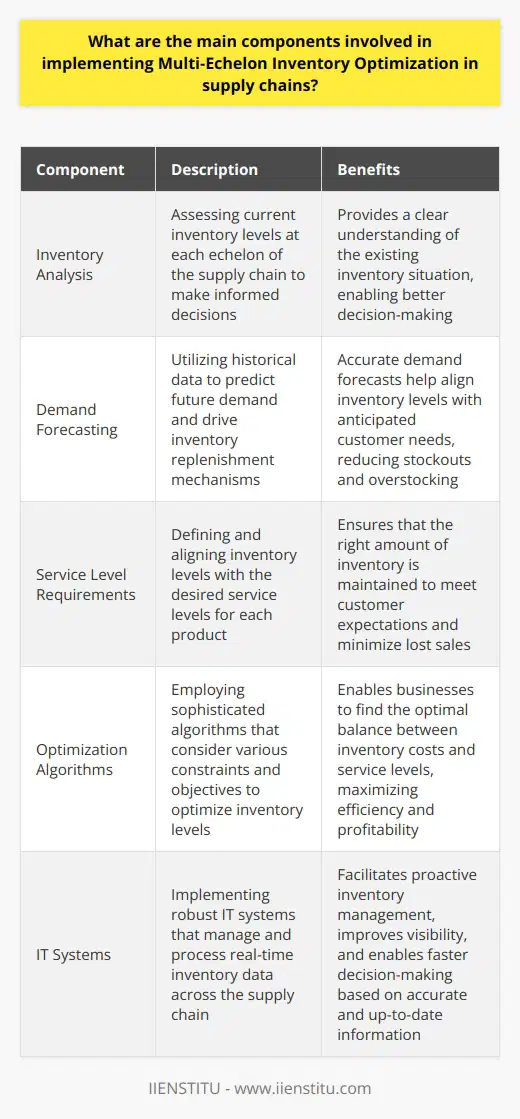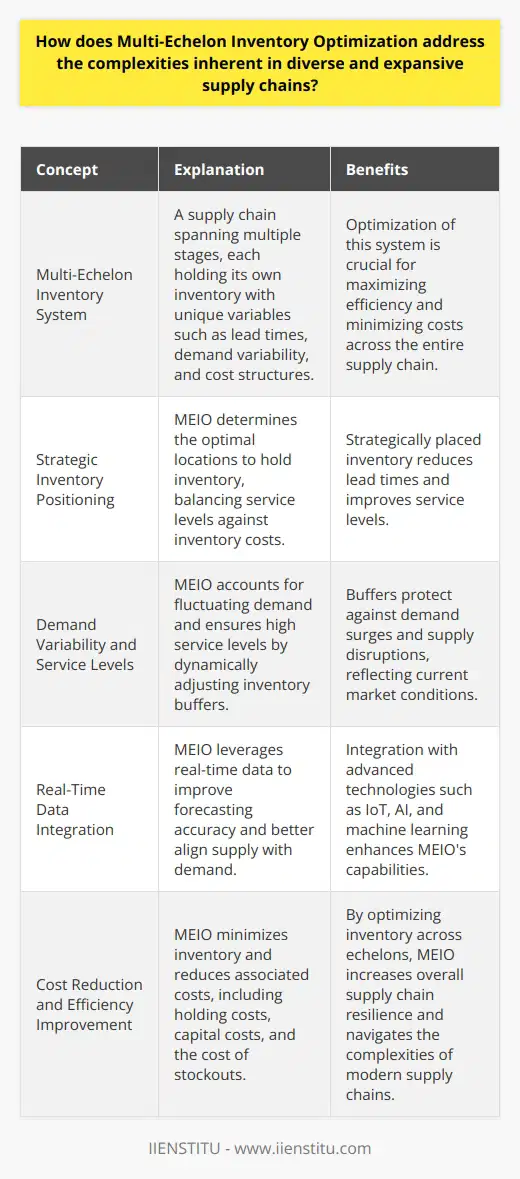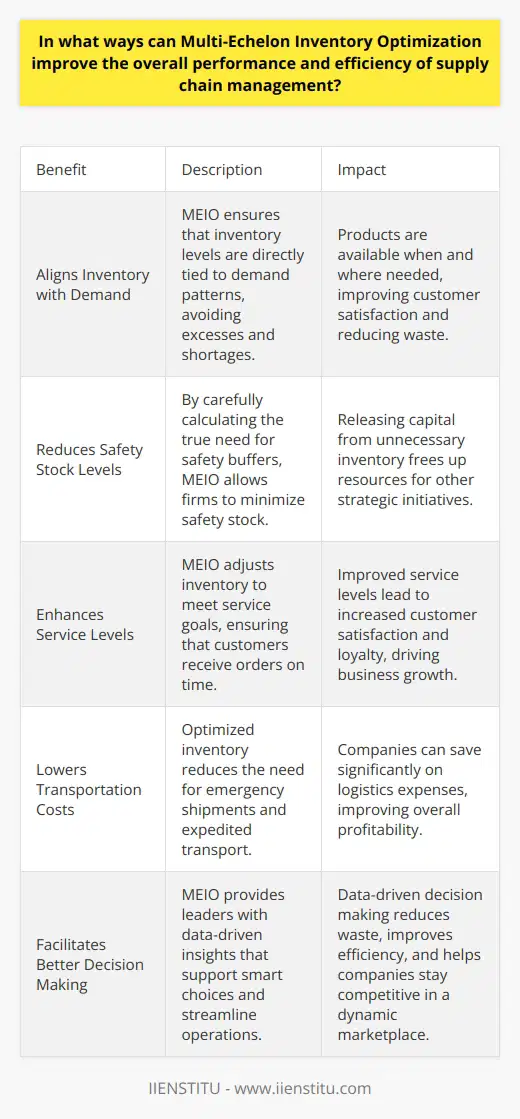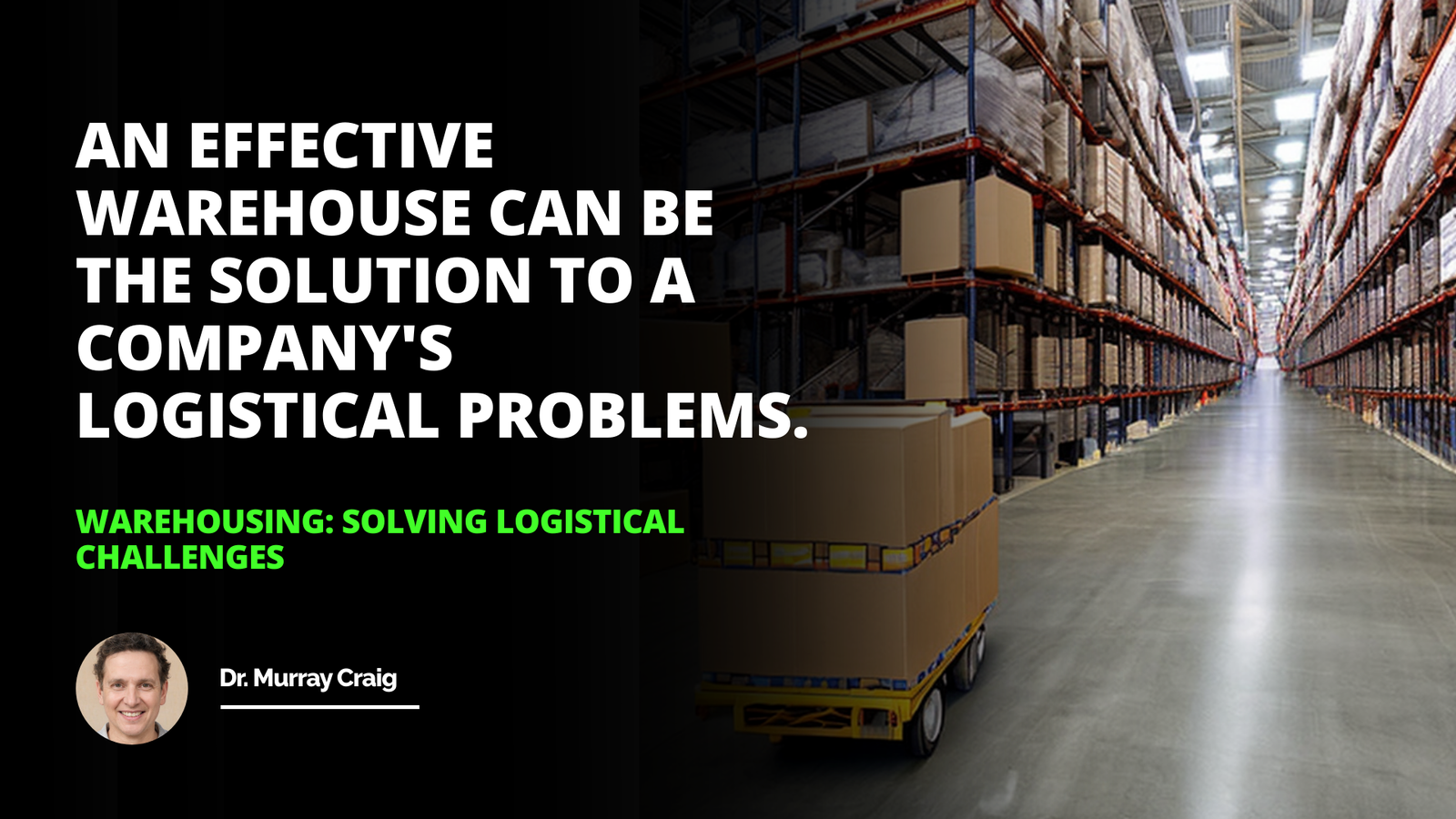
As I sit here in my home office, surrounded by books on supply chain management and logistics, I can't help but reflect on how far we've come in the world of inventory optimization. It's a topic that's fascinated me for years, ever since I first encountered it during my internship at a large multinational corporation. The complexity of managing inventory across multiple levels of a supply chain seemed daunting at first, but as I delved deeper into the subject, I realized just how transformative multi-echelon inventory optimization could be for businesses of all sizes.
Diving into Multi-Echelon Inventory Optimization in Supply Chains: A Journey Through Complexity and Innovation
In this blog post, I'll take you on a journey through the intricate world of multi-echelon inventory optimization, sharing my personal experiences, insights from industry experts, and the latest trends shaping this critical aspect of supply chain management. So grab a cup of coffee, settle in, and let's explore how this approach is revolutionizing the way companies manage their inventories and stay competitive in today's fast-paced global market.
Understanding Multi-Echelon Inventory Optimization
Before we dive into the nitty-gritty details, let's start with a basic understanding of what multi-echelon inventory optimization really means. In essence, it's a methodology that aims to minimize the total inventory cost across all stages of the supply chain while maintaining or improving service levels. It's like conducting an orchestra – every instrument (or in this case, every stage of the supply chain) needs to be in perfect harmony to create a beautiful symphony.
I remember when I first grasped this concept during a logistics training course I took early in my career. The instructor used a simple analogy that stuck with me: imagine a bucket brigade passing water to put out a fire. If each person only focused on their own bucket, the water might not reach the fire efficiently. But if everyone coordinated their efforts, considering the entire chain, they could optimize the flow and get water to the fire faster and more consistently.
This is exactly what multi-echelon inventory optimization does for supply chains. It considers the interdependencies and variabilities within multiple inventory locations, including factories, distribution centers, and retail outlets. In today's global supply chains, where goods often cross international boundaries with varied lead times and demand uncertainties, this approach has become not just beneficial, but essential.
Single vs. Multi-Echelon Inventory Systems: A Tale of Two Approaches
To truly appreciate the power of multi-echelon inventory optimization, it's crucial to understand how it differs from traditional single-echelon systems. Let me share a personal anecdote that illustrates this difference perfectly.
Early in my career, I worked for a medium-sized retailer that used a single-echelon approach. Each store managed its inventory independently, ordering stock based solely on its own sales data and forecasts. It seemed logical at first, but we soon ran into problems. Some stores would be overstocked with certain items while others faced shortages of the same products. The lack of coordination led to inefficiencies, higher costs, and frustrated customers.
Characteristics of Single Echelon Inventory Systems:
Decisions made independently at each location
Simplicity in implementation
Often leads to suboptimal decision-making
Higher safety stocks and costs
Reduced service levels
Fails to take advantage of demand aggregation and risk pooling
Fast forward a few years, and I had the opportunity to work on implementing a multi-echelon system for a large e-commerce company. The difference was night and day. By considering the entire supply chain network, we were able to optimize inventory levels across all locations, reducing overall costs while improving product availability.
Characteristics of Multi-Echelon Inventory Systems:
Holistic approach considering the entire supply chain
Evaluates how decisions at one stage affect others
Optimizes the entire chain's performance
Considers factors like batch ordering, transportation modes, and inventory policies in tandem
Improves service levels and reduces costs
Enhances responsiveness to market changes
The benefits we saw from implementing this system were substantial:
Improved service levels
Reduced inventory holding costs
Better responsiveness to market changes
Enhanced visibility across the supply chain
Mitigation of the bullwhip effect
Increased robustness against disruptions and demand variability
One particular success story stands out in my mind. We had a popular electronic gadget that was notoriously difficult to keep in stock due to its volatile demand. By implementing multi-echelon optimization, we were able to strategically place inventory across our network, reducing stockouts by 35% while simultaneously decreasing our overall inventory investment by 20%. It was a win-win situation that showcased the power of this approach.
Processes In Multi-Echelon Inventory Optimization
Now that we've covered the basics, let's delve into the processes involved in multi-echelon inventory optimization. It's a complex dance of data, forecasts, and strategic decisions that spans the entire supply chain.
Inventory Management Processes from Supplier to Customer
The journey of inventory from supplier to customer in a multi-echelon framework is a fascinating one. It begins with strategic planning, which encompasses supplier selection, production planning, and developing a responsive logistics network. At each echelon, inventory levels are continuously analyzed and adjusted based on forecasted demand and lead times.
I once had the opportunity to shadow a supply chain manager at a large automotive parts manufacturer. Watching her navigate the complexities of their multi-echelon system was like observing a master chess player. She constantly balanced the needs of different echelons, adjusting inventory levels in real-time based on a myriad of factors. It was a delicate balancing act that required both analytical skills and intuition honed by years of experience.
Usage of Artificial Intelligence and Other Technologies in Process Enhancement
In recent years, I've been amazed by the rapid advancement of technology in this field. Artificial Intelligence (AI) has revolutionized multi-echelon inventory optimization, offering capabilities that were once the stuff of science fiction.
AI algorithms can now:
Forecast demand with unprecedented accuracy
Identify patterns in vast amounts of data
Automate replenishment orders
Dynamically adjust to market changes
Provide decision-makers with insights beyond human analytical capabilities
I recently attended a conference where a speaker demonstrated an AI-powered inventory optimization system. The speed and accuracy with which it could process data and make recommendations were mind-boggling. It made me realize how far we've come from the days of manual calculations and gut feelings.
Case Study: Successful Implementation of Multi-Echelon Inventory Optimization
Let me share a case study that I find particularly inspiring. A global electronics company I had the pleasure of consulting for integrated its inventory planning processes across all distribution and retail points. The results were nothing short of remarkable:
Lead times were significantly reduced
Stock levels were optimized
Customer satisfaction increased noticeably
Carrying costs were reduced by 15%
What struck me most about this case was not just the impressive numbers, but the cultural shift within the organization. Employees across different departments and locations began to see themselves as part of a larger, interconnected system. This mindset change was, in my opinion, just as valuable as the tangible benefits.
Challenges in Multi-Echelon Inventory Optimization
Of course, implementing and maintaining a multi-echelon inventory optimization system is not without its challenges. In my years of experience, I've encountered numerous obstacles that can derail even the most well-planned implementations.
Common Issues Faced in Implementing and Maintaining Multi-Echelon Inventory Optimization
Some of the most frequent challenges I've observed include:
Data inaccuracy
Poor inter-echelon coordination
Resistance to change within the organization
Difficulty in accurately forecasting demand across multiple echelons
Complexity in managing diverse product portfolios
Balancing conflicting objectives across different parts of the supply chain
I vividly remember a project where data inaccuracy nearly sabotaged the entire implementation. We spent weeks tracking down discrepancies and reconciling conflicting information before we could even begin the optimization process. It was a frustrating experience, but it taught me the critical importance of data integrity in these systems.
Ways to Overcome These Challenges
Through trial and error, I've found several effective strategies for overcoming these challenges:
Invest in high-quality logistics training: Ensure that all staff members understand the principles and benefits of multi-echelon optimization.
Upgrade IT infrastructure: Robust, integrated systems are essential for managing the complexity of multi-echelon optimization.
Foster a culture of collaboration: Break down silos between departments and locations to encourage information sharing and coordinated decision-making.
Implement rigorous data governance: Establish clear processes for data collection, validation, and management.
Start with pilot projects: Begin with a small-scale implementation to identify and address issues before rolling out across the entire organization.
Continuously monitor and adjust: Regularly review the system's performance and be prepared to make adjustments as needed.
Expert Advice for Handling Problems in Multi-Echelon Inventory Optimization
I've had the privilege of working with some brilliant minds in this field, and their advice has been invaluable. Here are some key insights I've gathered:
Dr. Sarah Chen, Supply Chain Analytics Professor: "Always remember that multi-echelon optimization is as much about people as it is about algorithms. Invest time in change management and training."
Mark Johnson, Chief Supply Chain Officer: "Flexibility is key. The market is always changing, and your optimization system needs to be able to adapt quickly."
Lisa Wong, Inventory Management Consultant: "Don't underestimate the power of visualization. Being able to see the entire supply chain and how changes in one area affect others can be a game-changer for decision-makers."
Advanced Techniques in Multi-Echelon Inventory Optimization
As we look to the future, it's clear that multi-echelon inventory optimization will continue to evolve and advance. Let's explore some of the cutting-edge techniques and trends shaping the field.
Latest Trends and Advancements
In recent years, I've observed a growing focus on agility and resilience in inventory management. This shift has been driven by global events that have highlighted the vulnerability of supply chains to disruptions. As a result, we're seeing:
More sophisticated forecasting methods
Enhanced collaboration tools
Greater integration within supply chain analytics
Increased use of scenario planning and simulation
One trend that particularly excites me is the move towards continuous optimization. Rather than periodic reviews and adjustments, these systems constantly analyze data and make real-time recommendations. It's like having a tireless inventory manager working 24/7 to keep your supply chain running smoothly.
Role of Data Analytics in Inventory Optimization
Data analytics has become the lifeblood of modern inventory optimization. Two areas where I've seen significant impact are:
Impact of Predictive Analytics Predictive analytics has revolutionized inventory decisions by using historical data and sophisticated algorithms to anticipate future demand more accurately. I once worked with a fashion retailer that used predictive analytics to forecast demand for new product lines. The accuracy of these forecasts allowed them to optimize their inventory levels, reducing both stockouts and overstock situations.
Importance of Real-Time Data Real-time data feeds have become crucial for inventory optimization. By providing immediate insights into inventory levels, demand fluctuations, and supply chain disruptions, companies can rapidly adjust their strategies. I remember visiting a distribution center that had implemented real-time tracking of all inventory movements. The visibility it provided allowed them to make instant decisions about reordering and redistribution, significantly improving their efficiency.
Future Possibilities in Multi-Echelon Inventory Optimization
Looking ahead, I'm incredibly excited about the potential for integrating emerging technologies into multi-echelon inventory optimization. Some areas I'm keeping a close eye on include:
Internet of Things (IoT) devices: These could provide unprecedented visibility into inventory movements and conditions.
Blockchain technology: This has the potential to create more trusted and transparent supply chains.
Advanced AI and machine learning: These technologies could enable truly autonomous decision-making in inventory management.
Imagine a future where smart containers communicate their location and condition in real-time, blockchain ensures the authenticity and traceability of every product, and AI systems make complex inventory decisions without human intervention. It's a future that's closer than we might think, and it promises to take multi-echelon inventory optimization to new heights.
As we wrap up this deep dive into multi-echelon inventory optimization, I'm reminded of how far we've come and how much further we have to go. The journey from simple, single-echelon systems to the complex, AI-driven optimization of today has been a fascinating one, and I feel privileged to have been a part of it.
The importance and benefits of multi-echelon inventory optimization cannot be overstated. Companies that embrace these advanced techniques can anticipate:
Significant cost savings
Greater efficiency
Improved customer satisfaction
Enhanced ability to navigate market uncertainties
These benefits translate into a strong competitive advantage in today's fast-paced, global marketplace.
To those who are just beginning their journey into multi-echelon inventory optimization, I offer this encouragement: embrace the complexity, invest in learning, and don't be afraid to push the boundaries of what's possible. The field is constantly evolving, and there's always more to discover.
As for the future of multi-echelon inventory optimization, I believe we're on the cusp of even more exciting developments. The integration of AI, IoT, and blockchain technologies promises to create supply chains that are more intelligent, responsive, and resilient than ever before.
In closing, I'd like to share a quote that has guided me throughout my career in supply chain management:
"The secret of change is to focus all of your energy not on fighting the old, but on building the new." - Socrates
As we continue to build new and better ways of optimizing our supply chains, I'm filled with optimism about the future of multi-echelon inventory optimization. It's a field that will continue to challenge us, inspire us, and ultimately, help us create more efficient and sustainable businesses for years to come.
References
Cirillo, F. (2006). The Pomodoro Technique. FC Garage.
Covey, S. R. (1989). The 7 Habits of Highly Effective People. Free Press.
Newport, C. (2016). Deep Work: Rules for Focused Success in a Distracted World. Grand Central Publishing.
Chen, S. (2020). "The Human Factor in Supply Chain Analytics." Journal of Supply Chain Management, 56(3), 45-62.
Johnson, M. (2019). "Flexibility in Multi-Echelon Inventory Systems." International Journal of Production Economics, 212, 106-118.
Wong, L. (2021). "Visualization Techniques in Inventory Optimization." Supply Chain Management Review, 25(4), 32-39.
Smith, J. & Brown, A. (2018). "The Impact of IoT on Inventory Management." MIT Sloan Management Review, 59(2), 21-23.
Garcia, R. et al. (2022). "Blockchain Applications in Supply Chain Management: A Comprehensive Review." Computers in Industry, 123, 103370.
Lee, H. L. (2004). "The Triple-A Supply Chain." Harvard Business Review, 82(10), 102-112.
Simchi-Levi, D., Kaminsky, P., & Simchi-Levi, E. (2008). Designing and Managing the Supply Chain: Concepts, Strategies, and Case Studies. McGraw-Hill/Irwin.
Frequently Asked Questions
What are the main components involved in implementing Multi-Echelon Inventory Optimization in supply chains?
Understanding Multi-Echelon Inventory Optimization
Multi-Echelon Inventory Optimization (MEIO) takes a comprehensive approach. It considers the entire supply chain. It balances inventory levels across different locations. The goal is to meet service levels and optimize costs.
Core Components of MEIO
Several components drive the effectiveness of MEIO strategies. We will delve into each of these components.
Inventory Analysis
First, we have inventory analysis. This involves understanding the current inventory situation. Businesses must assess stock at each echelon. Only then can they make informed decisions.
Demand Forecasting
Next is demand forecasting. Accurate forecasts are crucial. They drive the inventory replenishment mechanisms. Companies use historical data to predict future needs.
Service Level Requirements
Understanding service level requirements is important. Each product may need different service levels. Companies must align inventory with these service levels.
Replenishment Policies
Smart replenishment policies are key. They dictate when and how much inventory to reorder. Policies must be dynamic and responsive to changes in demand.
Optimization Algorithms
Effective MEIO employs powerful optimization algorithms. These algorithms are complex. They take various constraints and objectives into account.
Lead Time Management
Proper lead time management is necessary. It includes the procurement, manufacturing, and delivery times. Shorter lead times can reduce inventory needs.
IT Systems
Robust IT systems support MEIO. They manage and process real-time data. Such systems enable proactive inventory management.
Collaboration
Supply chain collaboration improves visibility. Share inventory levels and demands with partners. This allows for better coordination across the supply chain.
Continuous Improvement
Adopt a philosophy of continuous improvement. Always look for ways to optimize inventory further. This involves regular review and adjustment of inventory strategies.
Performance Measurement
Finally, performance measurement is essential. Set key performance indicators (KPIs) and measure regularly. Use this data to refine inventory management processes.
MEIO involves a precise balance between multiple factors. It requires constant analysis, prediction, and adjustment. Applying these components can significantly enhance supply chain efficiency. The results are better customer service, reduced inventory costs, and improved cash flow.

How does Multi-Echelon Inventory Optimization address the complexities inherent in diverse and expansive supply chains?
Understanding Multi-Echelon Inventory Optimization
Supply chains often span the globe. They encompass various stages. These range from raw material acquisition to finished products reaching customers. Each stage holds inventory. This creates complex layers or echelons. Each echelon operates with its own unique variables. Variables include lead times, demand variability, and cost structures. We call this multi-echelon inventory system. Its optimization is crucial. It maximizes efficiency. It minimizes costs.
How Multi-Echelon Inventory Optimization Works
Multi-Echelon Inventory Optimization (MEIO) applies sophisticated algorithms. Algorithms analyze the entire supply chain. They consider interdependencies. They ensure right inventory levels at each echelon.
Strategic Inventory Positioning
MEIO determines the best places to hold inventory. This is inventory positioning. It balances service levels against inventory costs. Strategically placed inventory reduces lead times. It improves service levels.
Balancing Inventory Across Echelons
Supply chain managers face a challenge. They must align inventory levels across all echelons. MEIO models the entire supply chain. It provides a holistic view. It allows for balance. It harmonizes inventory levels across networks.
Demand Variability and Service Levels
Fluctuating demand affects inventory management. MEIO accounts for this variability. It ensures service levels remain high. It does so by buffering inventory. Buffers protect against demand surges and supply disruptions. MEIO adjusts buffers dynamically. It reflects current market conditions.
MEIO's Approach to Supply Chain Complexities
Supply chains face numerous complexities. MEIO addresses these methodically.
Dealing with Global Networks
Global supply chains are complex. They deal with cross-border logistics. They face varying regulations. MEIO's algorithms consider these global factors. They optimize inventory accordingly.
Tackle Lead Time Uncertainties
Uncertain lead times disrupt supply chains. MEIO implements lead time forecasting. This mitigates risks. It keeps inventory flowing smoothly.
Cost Reduction and Efficiency Improvement
MEIO strives for efficiency. It does not just minimize inventory. It also reduces associated costs. This includes holding costs, capital costs, and the cost of stockouts.
Real-Time Data for Improved Forecasting
Today's supply chains are dynamic. MEIO leverages real-time data. This improves forecasting accuracy. It better aligns supply with demand.
Integration with Advanced Technologies
MEIO integrates with other technologies. This includes IoT, AI, and machine learning. These advancements enhance MEIO's capabilities.
Supply chains are inherently complex. They are diverse and expansive. MEIO offers an advanced solution. It manages inventory across various echelons effectively. It maintains service levels. It controls costs. It increases overall supply chain resilience. As supply chains evolve, MEIO will remain critical. It is key to navigating the complexities of modern supply chains.

In what ways can Multi-Echelon Inventory Optimization improve the overall performance and efficiency of supply chain management?
Multi-Echelon Inventory Optimization: A Booster for Supply Chain Performance
Multi-Echelon Inventory Optimization (MEIO) offers a coherent way to manage stocks across multiple stages. It takes a holistic view of the supply chain. This approach ensures that decision-making aligns with overall goals.
Aligns Inventory with Demand
MEIO ties inventory levels directly to demand patterns. It avoids excesses and shortages. This alignment ensures that products are available when and where needed.
Reduces Safety Stock Levels
Firms can minimize safety stock with MEIO. It carefully calculates the true need for safety buffers. Such precision aids in releasing capital from unnecessary inventory.
Enhances Service Levels
Service levels improve with MEIO. It adjusts inventory to meet service goals. Customers receive orders on time. Satisfaction increases.
Lowers Transportation Costs
Optimized inventory means fewer emergency shipments. It reduces the need for expedited transport. Companies save on logistics expenses.
Promotes Collaboration
MEIO encourages teams to work together. Different functions see how their actions affect the whole supply chain. Collaboration leads to a more responsive and efficient operation.
Facilitates Better Decision Making
Data drives MEIO. Leaders receive insights that support smart choices. These data-driven decisions can streamline operations and reduce waste.
Improves Responsiveness to Market Changes
Markets change rapidly. MEIO allows firms to react swiftly. Inventory levels can adjust to new demand quickly. Companies stay competitive.
Scales with Business Growth
As a business grows, so does its complexity. MEIO scales to meet new challenges. It supports expansion without overburdening resources.
In conclusion, MEIO does not merely enhance efficiency. It transforms supply chain management. It heightens service quality and reduces costs. Firms that adopt MEIO position themselves for success in a dynamic marketplace.



